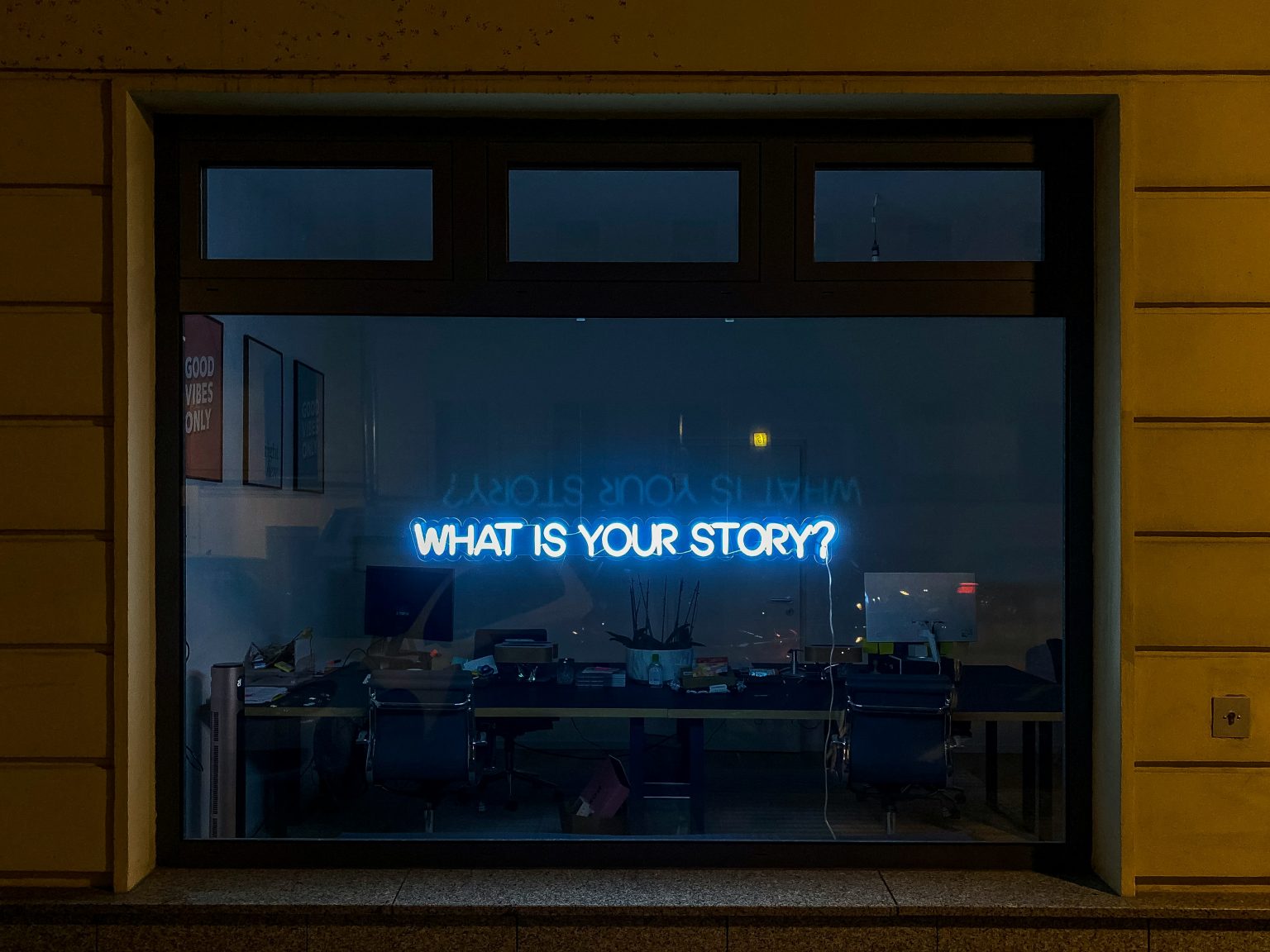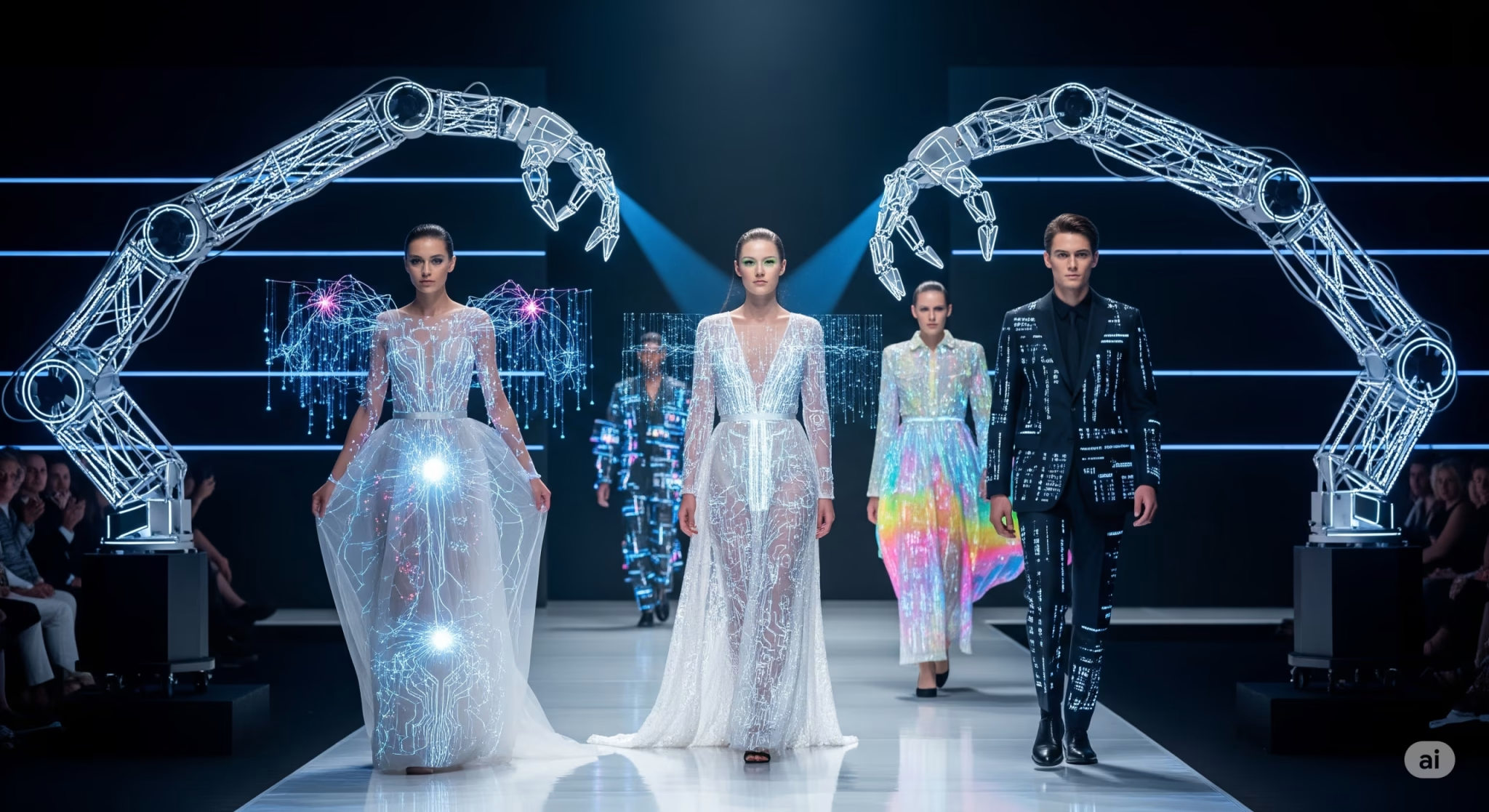The power of storytelling in fashion: how to structure a compelling brand narrative
October 2, 2025
Decoding the narrative mechanisms that transform fashion brands into desirable cultural universes, from Jacquemus to Guerlain.

The Narrative Imperative: Why Storytelling Is No Longer Optional
In fashion history, a shift occurred somewhere between the era when Coco Chanel declared “Fashion fades, style is eternal” and our current image-saturated present. This shift has a name: the attention economy. Today, it’s not clothing that’s in short supply, but the seconds during which a consumer agrees to consider your brand over another.
The data is unforgiving: we’re exposed to over 10,000 commercial messages per day. In this deafening noise, the brands that break through aren’t the ones shouting the loudest, but those whispering the most captivating stories. LVMH understands this: each house in the group, from Louis Vuitton to Dior, has now mastered the art of weaving narratives that go beyond the simple product.
But what separates a good story from plain marketing speak?
The answer lies in an anthropological truth: human beings are narrative animals. Since the dawn of time, it’s through stories that we understand the world, pass on our values, and build our identity. When a brand tells an authentic story, it’s no longer just selling a product: it’s offering a fragment of identity, a piece of narrative in which the consumer can see themselves.

The anatomy of effective fashion storytelling: beyond the founding narrative
The “Once Upon a Time” Trap
Too many emerging brands confuse storytelling with biography. They tell the story of their founder, their passion for fashion, their life-changing trip to Tuscany, waking up at 4am to sew the first collection. It’s a start, but it’s not enough.
Powerful storytelling doesn’t tell where you come from, but where you’re taking your customers.
Take the masterful example of Jacquemus. Simon Porte Jacquemus could have simply told his personal story: a boy from the South of France who moves to Paris with a dream. Instead, he built an entire Mediterranean mythology. His runway shows in the lavender fields of Provence, his viral mini bags, his surreal installations — none of this tells “Simon’s story,” but rather invites the audience into a universe where the Mediterranean becomes a state of mind, a life aesthetic.
When you buy Jacquemus, you’re not buying a garment: you’re buying a ticket to Valensole, an imaginary lunch on a terrace in Cassis, a fragment of that sun-drenched carefree spirit that the brand has distilled into a commercial product.
The Three Pillars of Brand Storytelling That Resonates
1. The Invisible Antagonist: The Cultural Problem You’re Solving
Every great story starts with a conflict. In fashion, the most relevant brands don’t just sell aesthetic solutions — they address deep cultural tensions.
Patagonia doesn’t sell technical jackets, it fights overconsumption. Its legendary “Don’t Buy This Jacket” campaign isn’t a marketing stunt: it’s the expression of a narrative tension. The antagonist? Blind consumerism, fast fashion, environmental destruction. The hero? You, the consumer, who chooses the alternative.
In French fashion, Jacquemus tackles a different antagonist: Parisian pretension, inaccessible and stuffy luxury. By staging his shows in fields rather than palaces, by creating (relatively) accessible prices for French luxury, he resolves a tension: how to access the French dream without the traditional elitism?
Strategic question: What cultural tension does your brand resolve? What is your narrative proposition beyond your value proposition?
2. The Semantic Universe: The Signals That Crystallize Your World
A strong brand doesn’t use just any words, any colors, any visual codes. It builds a proprietary language, a system of signs recognizable anywhere.
Cartier masterfully demonstrated this with its “L’Odyssée” series: a 3-minute short film tracing 165 years of history by following a panther (their emblem) through the decades. The panther isn’t just a logo: it becomes a character, a symbol, a narrative thread running through all of the brand’s communication.
For emerging brands, building this semantic universe requires discipline:
- Reduced color palette: Jacquemus = beige/terracotta/Mediterranean blue. The Row = black/white/cream.
- Distinctive vocabulary: Replace “collection” with “chapter,” “boutique” with “space,” “sale” with “access.”
- Visual recurrences: An element that returns systematically (a texture, a pattern, a proportion ratio) quickly becomes identifiable.
3. Narrative Temporality: Yesterday, Today, Tomorrow
The great luxury houses have understood this for a long time: effective storytelling plays on three simultaneous temporalities.
The past as legitimacy: Guerlain, founded in 1828, never misses an opportunity to mention its 190 years of history. But be careful: this isn’t gratuitous nostalgia. Each historical reference serves to anchor the brand in a tradition of craftsmanship, quality, excellence.
The present as relevance: How does your heritage express itself today? Louis Vuitton brilliantly solved this equation by inviting contemporary artistic directors (Virgil Abloh, Pharrell Williams) to reinterpret the house’s historical codes. The century-old monogram becomes streetwear, the trunk maker becomes cultural.
The future as aspiration: Where are you going? What vision do you carry? The most powerful brands don’t just tell their past: they project a desirable future. TAG Heuer doesn’t sell watches, it sells “Don’t Crack Under Pressure”, a vision of yourself as someone who performs under stress.
Publications récentes
Follow us!
Follow us to discover more stories, tips, and daily inspiration!
Ready to Turn Your Idea into Reality?
If you’ve got an idea that won’t let you rest, we’re ready to help. Contact us on WhatsApp, and let’s talk about how we can bring your vision to life with our full range of services.
Narrative formats: from fashion shows to TikTok, adapting stories to the medium
The Revolution of Fragmented Storytelling
The era when a brand told its story in a linear way (print campaign, runway show, lookbook) is over. We’re living in the age of atomized storytelling: your story must be able to unfold in coherent fragments across a dozen different platforms, in radically distinct formats.
This is the challenge that LVMH group brands took on by rethinking their narrative approach on YouTube. Guerlain, Louis Vuitton and TAG Heuer developed multi-format strategies where the same story unfolds in:
- Long-form documentary (8-15 minutes): For enthusiasts who want to dive deep into the universe
- Snackable format (30-60 seconds): To capture attention on social media
- Episodic series: To create appointments and build loyalty
- Behind-the-scenes content: For authenticity and proximity
The Runway Show as Total Narrative
In contemporary fashion, the runway show is no longer a simple collection presentation: it’s become the culminating narrative moment, when the brand’s story materializes in space and time.
Jacquemus revolutionized this format. His Spring/Summer 2020 show in the lavender fields of Valensole wasn’t a gratuitous aesthetic choice: it was a narrative statement. By leaving the Parisian Fashion Weeks, by literally planting his show in the Provençal landscape, he was saying: “This brand belongs to the South, to the light, to a certain idea of France outside Parisian codes.”
The result? Images that went around the world, instantly becoming iconic. Because they didn’t just show clothes: they told a complete visual story, a world you wanted to live in.
The formula for a successful narrative runway show:
- The location as first character: Where does the action take place? What does this place say about your universe?
- Scenography as metaphor: Every visual element must serve the message (lighting, music, rhythm)
- Casting as microcosm: Who are the models? What do they represent? What diversity, what uniqueness?
- Narrative timing: The order in which looks appear also tells a progression
Boutiques as Physical Chapters
Retail space isn’t just a point of sale: it’s a physical chapter of your narrative.
Jacquemus understood this once again, by creating boutiques with surreal facades and interiors. In Paris, his boutique looks like a giant pink dollhouse. In London, it’s a bright green facade that defies the codes of understated luxury.
These spaces aren’t stores: they’re narrative installations where the customer becomes a character in a story bigger than themselves. Entering Jacquemus is like stepping through the looking glass into the brand’s fantasy universe.
Retail storytelling principles:
- The entrance as prologue: The first 10 feet determine whether the visitor stays or leaves. What do they see? What first narrative impression?
- The journey as progression: Don’t arrange your products randomly. Create a flow that tells a story: discovery of icons → exploration of novelties → intimacy of fitting rooms.
- Details as Easter eggs: Plant narrative elements that only insiders will spot. An engraved quote, an archival photo, an object symbolic of your story.
Fatal narrative mistakes (and how to avoid them)
The Four Fatal Mistakes in Brand Storytelling (And How to Avoid Them)
Every strategy has its pitfalls. Here are the four most common mistakes that can turn your brand storytelling into a liability rather than an asset.
1. Disconnected Storytelling: When Your Story and Product Don’t Talk to Each Other
The hollow story syndrome: You talk about your commitment to ethical craftsmanship, but your products are standardized and clearly industrial. You evoke timeless luxury, but your quality doesn’t follow through. You speak of sustainability, but your collections change every 6 weeks.
Negative case study: Fast fashion brands launching “eco-responsible collections” made of 5% organic cotton mixed with polyester, while continuing to mass-produce. The public isn’t fooled. The gap between the narrative and reality creates cynicism, even worse than the absence of storytelling.
The solution: Storytelling must be the narrative expression of a tangible reality. If you can’t prove what you’re telling, don’t tell it. Authenticity isn’t a creative choice: it’s a strategic necessity.
Patagonia can afford “Don’t Buy This Jacket” because its supply chain, commitments, legal structure (benefit corporation), its Worn Wear repair program: everything validates the narrative. Story and actions are aligned.
2. The Founder-Hero Syndrome: Narrative Ego
The mistake: Building the entire narrative around the founder’s personality, to the point where the brand doesn’t exist independently of them.
This is a particularly common trap among fashion designers, who naturally have strong personalities. But a brand that only tells its founder’s story condemns itself to limited scalability.
Why is this problematic?
- What happens if the founder leaves, ages, or loses relevance?
- How can the brand evolve if everything is centered on a single voice?
- Are customers attached to the brand or to the character?
The balance to find: The founder can be the initial narrator, the one who lays the foundations of the universe, but the brand must gradually develop an autonomous narrative existence.
Karl Lagerfeld at Chanel is the perfect example of this balance: he never tried to be Chanel, but to interpret the Chanel universe. His personality served the brand, didn’t cannibalize it.
3. Tonal Inconsistency: When Your Voice Changes Across Platforms
The symptom: Your website is sober and luxurious, your Instagram is casual and fun, your emails are corporate and cold. Your customer no longer knows who you really are.
The root of the problem: Absence of “brand voice guidelines.” Each person creating content (community manager, copywriter, designer) interprets the brand in their own way, creating narrative cacophony.
The solution: Precisely document your brand voice:
- General tone: Are you formal or casual? Technical or emotional? Minimalist or verbose?
- Recurring vocabulary: Which words come up systematically? Which are forbidden?
- Sentence structure: Long and literary or short and punchy?
- Level of intimacy: Do you use informal language? Do you speak in first person?
Create a 3-4 page document with concrete examples: “We would say this / We would never say that.” Test each new piece of content against these guidelines.
4. The Originality Obsession: Reinventing the Narrative Wheel
The mistake: Thinking you absolutely must tell a never-before-seen story, invent unprecedented narrative concepts.
The reality: According to Christopher Booker, there are only 7 basic narrative archetypes. All the world’s stories are variations around these structures. What matters isn’t the originality of the framework, but the authenticity of your variation.
Example: The “Rags to Riches” archetype is as old as time. But when Good American (co-founded by Khloé Kardashian) uses it to tell the story of exclusion experienced in boutiques (“I had to shop in a different section from my sisters”), it becomes powerful because it’s specific, embodied, credible.
Don’t try to be original. Try to be authentic, specific, and consistent.
Narrative evolution: how to bring your story to life over time
The Trap of Narrative Fixity
Common mistake: thinking that once your storytelling is established, it’s set in stone. That’s wrong. A living brand has a story that evolves, while remaining true to its DNA.
Think of TV series: characters evolve, new story arcs appear, but the universe remains coherent. Game of Thrones season 1 and season 8 are very different, but we’re still in the same world.
The “Chapters” and “Seasons” System
Structure your brand narrative like a series:
- Seasons (1-2 years): A major narrative theme that guides all your communication. Example: “The season of origin” (year 1: telling your roots), then “The season of expansion” (year 2: international opening), then “The season of impact” (year 3: environmental commitment).
- Chapters (collections, 3-6 months): Each collection is a chapter within the current season. Example: If you’re in the “season of origin,” your Spring collection can be “Chapter I: The fabrics of my childhood,” your Fall collection “Chapter II: The colors of my city.”
- Episodes (campaigns, launches): Specific narrative moments that enrich the chapter.
This structure allows you to constantly refresh your message while maintaining overall coherence. Your customers feel like they’re following a saga, not hearing a message repeated ad nauseam.
Narrative “Plot Twists”: Collaborations and Events
The strong moments of your narrative evolution often come from orchestrated surprises: a surprise collaboration, a change in creative direction, a new commitment.
Jacquemus x Nike: When the accessible-luxury Provençal brand collaborates with the sportswear giant, it’s not just a commercial operation. It’s a narrative plot twist: “What if the South of France met California streetwear?”
Louis Vuitton x Yayoi Kusama: When the century-old French house partners with the Japanese artist obsessed with polka dots, it tells the story: “Our heritage isn’t frozen, it dialogues with the boldest contemporary art.”
These moments must be rare (maximum 1-2 per year) to maintain their narrative impact. Too many collaborations kills collaboration.
The future of fashion storytelling: towards narrative hyper-personalization
The Emergence of “Algorithmic Storytelling”
We’re entering a fascinating era: one where artificial intelligence allows narrative personalization in real-time based on the visitor’s profile.
Imagine: the same e-commerce site telling a slightly different story depending on whether you’re a new visitor (focus on the manifesto, the origin), a returning customer (focus on new arrivals, loyalty), or someone coming from a press article (focus on external validation, awards received).
Some platforms like Mercer.design are starting to integrate these AI narrative logics, where content adapts to the visitor’s context.
The risk: Losing authenticity in what you gain in personalization. The algorithm can optimize, but it must not distort.
The opportunity: Telling the same fundamental story, but through the most relevant entry points for each person.
Case study: masters of contemporary storytelling
Supreme: Storytelling Through Scarcity and Mystery
Supreme built a $2.1 billion empire (acquired by VF Corporation in 2020) not by telling an explicit story, but by creating a narrative void that the community filled.
The genius of the Supreme approach? Silence as narrative strategy.
No traditional advertising, no press releases, no interviews with founder James Jebbia. This silence creates mystery, and mystery generates speculation. The community becomes the author of the brand’s story.
The drop as narrative event: Every Thursday, a new limited collection drops. No pre-orders, no restocking. This ritualization creates a narrative temporality: Supreme time isn’t normal time. Missing a drop means missing a chapter.
Collaboration as plot twist: Supreme x Louis Vuitton (2017) wasn’t just a fashion collab. It was a cultural moment, the collision of two worlds (streetwear and luxury) that weren’t supposed to meet. The story wrote itself in real-time on social media.
The lesson: The most powerful storytelling isn’t always the one you control, but the one you allow your community to build. Supreme provides the ingredients (products, collaborations, drops) and lets the fans write the story.
Aesop: Anti-Storytelling as Ultimate Storytelling
Aesop, the Australian cosmetics brand acquired by L’Oréal for $2.5 billion in 2023, practices what could be called “narrative anti-marketing”, and that’s precisely what makes it powerful.
Aesop’s narrative principles:
- Architecture as narration: Each Aesop boutique is unique, designed by a different architect to integrate with its local environment. The Tokyo store doesn’t look like the Paris one, which doesn’t look like the Melbourne one. The narrative message? “We respect place, history, context.” Over 400 boutiques, zero standardization.
- The philosophy of “unselling”: Staff aren’t trained to sell, but to educate. No sales pressure, no closing techniques. The narrative becomes: “We believe so deeply in our products that we don’t need to convince you.”
- Proprietary language: Aesop product descriptions blend poetry and science. They don’t say “moisturizing cream,” but “fortifying emulsion with botanical antioxidants.” This vocabulary creates a unique linguistic universe, recognizable anywhere.
- Invisible narrative details: Paper bags carry quotes from authors, different according to city. Gift wrapping uses natural cords and scientific labels. Every micro-interaction reinforces the narrative of a brand that thinks, reads, respects customer intelligence.
For Aesop, the message is that Luxury today isn’t expressed through ostentation, but through attention to detail, respect for context, refusal of standardization. Aesop tells the story: “We’re different because we refuse to be like everyone else.”
Conclusion: From product to myth, storytelling as transformation
We’re at a pivotal moment in fashion history. The technical barriers to entry have never been lower: you can create a brand with a Shopify store and an Instagram account. But paradoxically, standing out has never been harder.
In this saturated landscape, storytelling is no longer a marketing “nice to have”: it’s become the main differentiating asset. Your products can be copied, your prices undercut, your aesthetic replicated. But your story, if it’s authentic, coherent, and deeply rooted in who you are, is inimitable.
The brands that will thrive in the next decade won’t be those with the biggest marketing budget, but those telling the most coherent, truest, most necessary story.
The question is no longer “What do you sell?” but “What story do you tell, and why should we care?”
🔗 Related articles for further reading
- How AI is Revolutionizing Emerging Fashion. Discover how artificial intelligence is transforming trend detection and creation
- The Most Common Mistakes When Launching a Fashion Brand. Avoid the pitfalls that compromise your brand launch
- How to Make Your Fashion Brand Stand Out. Differentiation strategies in a saturated market
Ready to Turn Your Idea into Reality?
If you’ve got an idea that won’t let you rest, we’re ready to help. Contact us on WhatsApp, and let’s talk about how we can bring your vision to life with our full range of services.




